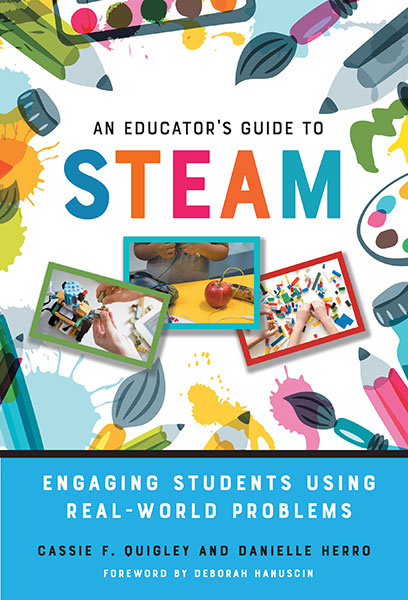Professors: Request an Exam Copy
Print copies available for US orders only. For orders outside the US, see our international distributors.
Cassie F. Quigley, Danielle Herro
Foreword by: Deborah Hanuscin
Publication Date: March 29, 2019
Pages: 168

This practical book will help readers understand what STEAM is, how it differs from STEM, and how it can be used to engage students in K–8 classrooms.
The authors present a conceptual model with recommendations and classroom examples illustrating various key aspects of STEAM teaching in action, including creating the correct teaching environment, integrating STEAM content, and supporting students as they develop STEAM-related skills. The model includes specific strategies such as problem-based learning, student choice, technology integration, and teacher facilitation. Each chapter incorporates elements of connected learning—a type of learning that draws on students’ interests that teachers can capitalize on when using STEAM to address real-world problems.
Readers will find easy-to-understand examples of what STEAM education looks like in a variety of classrooms, and will hear from teachers, instructional coaches, principals, and administrators about what it takes to ensure that STEAM is a schoolwide success.
Book Features:
Cassie F. Quigley is an associate professor of science education at the University of Pittsburgh. Danielle Herro is an associate professor of digital media and learning at Clemson University.
“This book provides a well-realized conceptual framework for various stakeholders who are interested in successful implementation of STEAM education in K-12 public schools. The framework and suggestions are grounded in evidence from the authors’ sustained partnerships and fieldwork in STEAM. This book will be a valuable resource for all who are interested in learning more about STEAM and implementing it in their own schools and districts.”
—Teachers College Record
“As a teacher, and now teacher educator, I understand the complexity of teaching and the difficulty of enacting change in one’s practice—such as shifting to STEAM teaching. The authors of this book do due diligence in unpacking this complexity and discussing specific barriers teachers and schools might face in this undertaking. More importantly, they provide inspiration to sustain readers through this challenging work by emphasizing the rewards for both students and educators who engage in STEAM education.”
—From the Foreword by Deborah Hanuscin, Western Washington University
“The authors do a wonderful job of unraveling what STEAM actually is and what it is not. This text will be appreciated by school and district staff interested in implementing STEAM education for students. The book provides wonderful real-life examples of implementation strategies and clarification on the many misconceptions of STEAM instruction.”
— Kevin O’Gorman, chief academic officer, Berkeley County School District, South Carolina
“An Educator's Guide to STEAM will become a go-to for crafting meaningful STEAM learning experiences for students. The STEAM conceptual model grounded in principles of Connected Learning is useful and approachable, all while tying back to research. Quigley and Herro thoughtfully address the need for district-level support and visioning for STEAM education, which is often forgotten. Among the greatest strengths of this guide are all of the examples from real classrooms and schools, across grade levels and school contexts.”
—Nicole Beeman-Cadwallader, senior director of curriculum and design, National Math and Science Initiative
Professors: Request an Exam Copy
Print copies available for US orders only. For orders outside the US, see our international distributors.